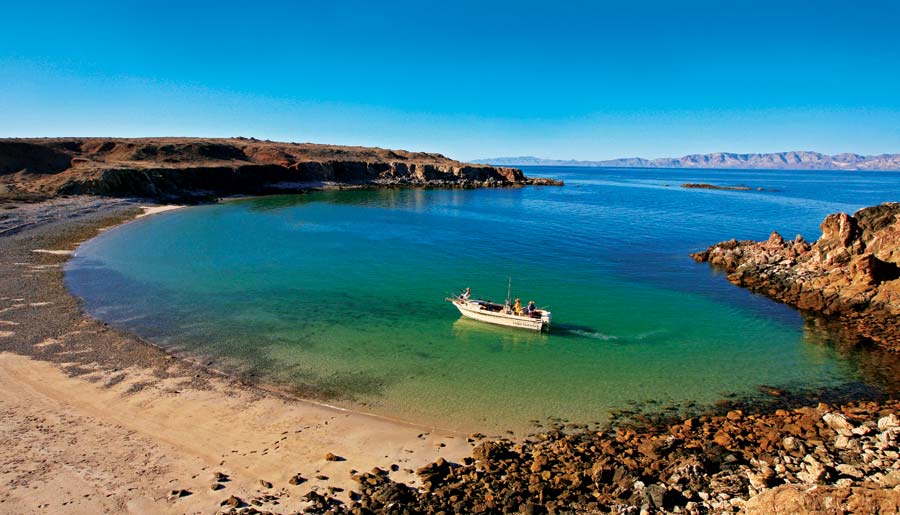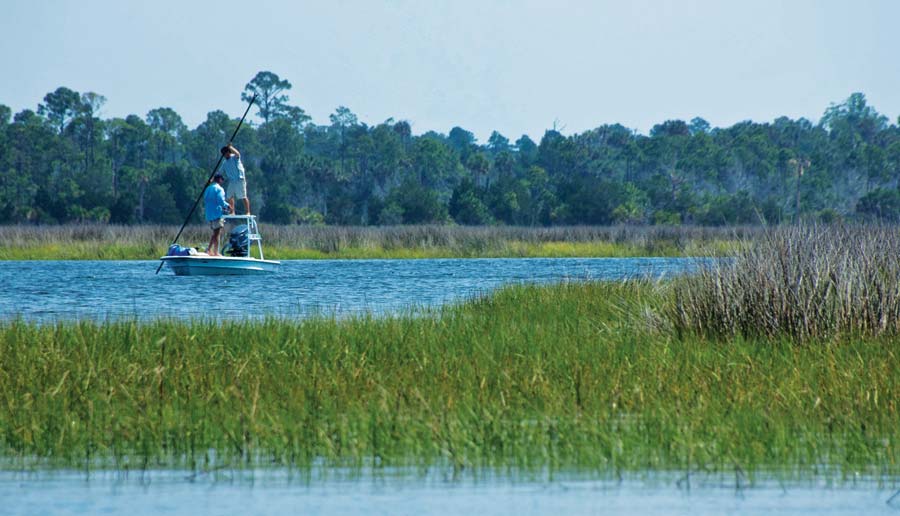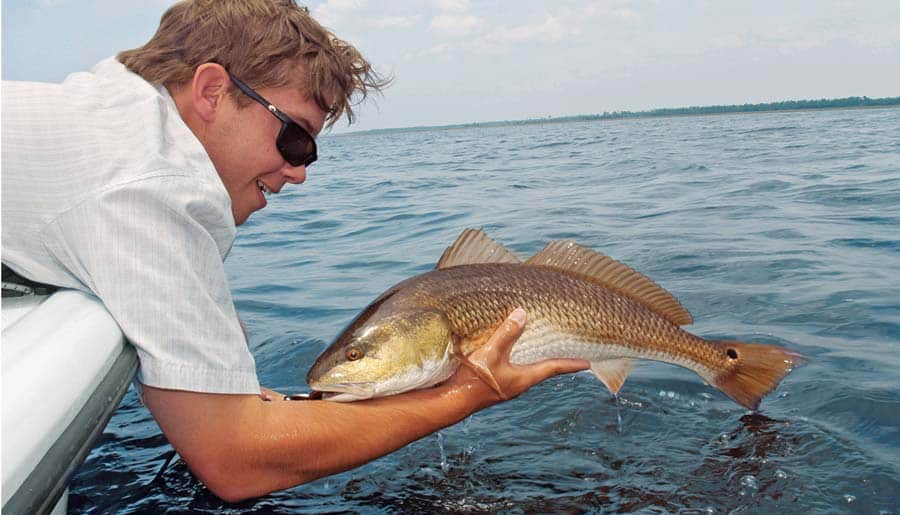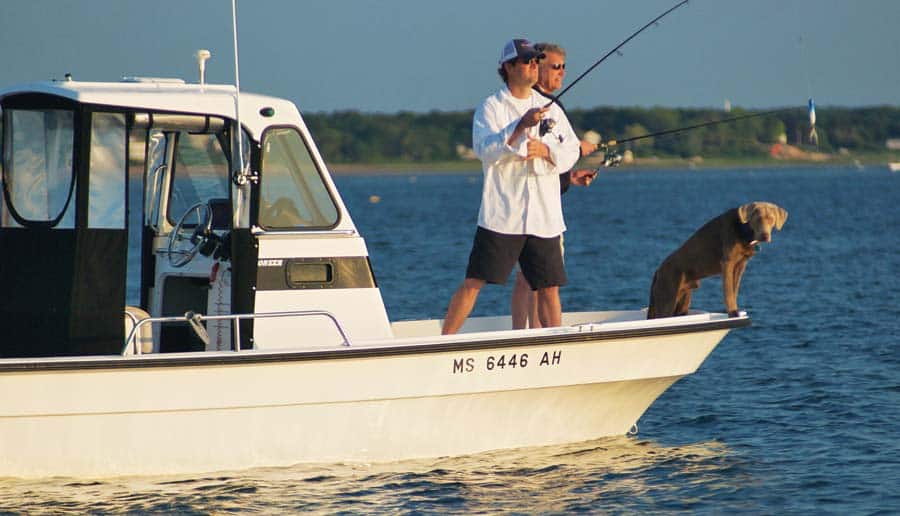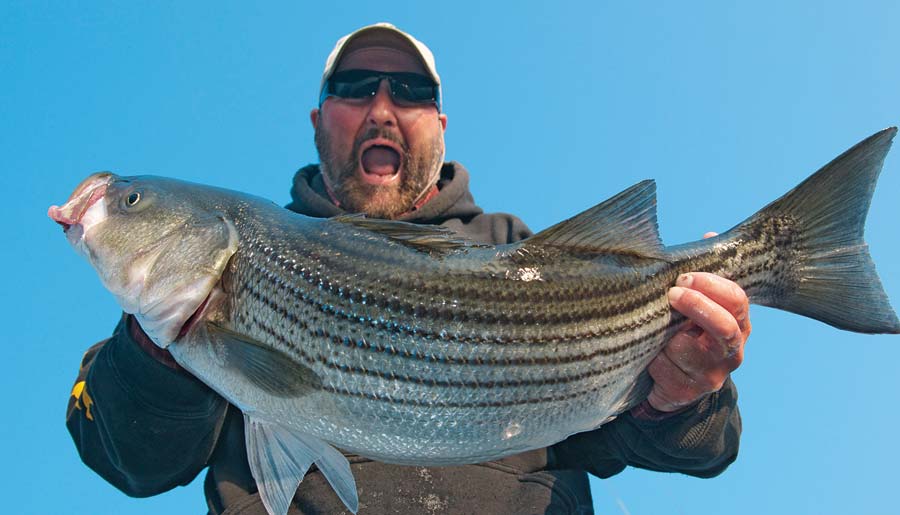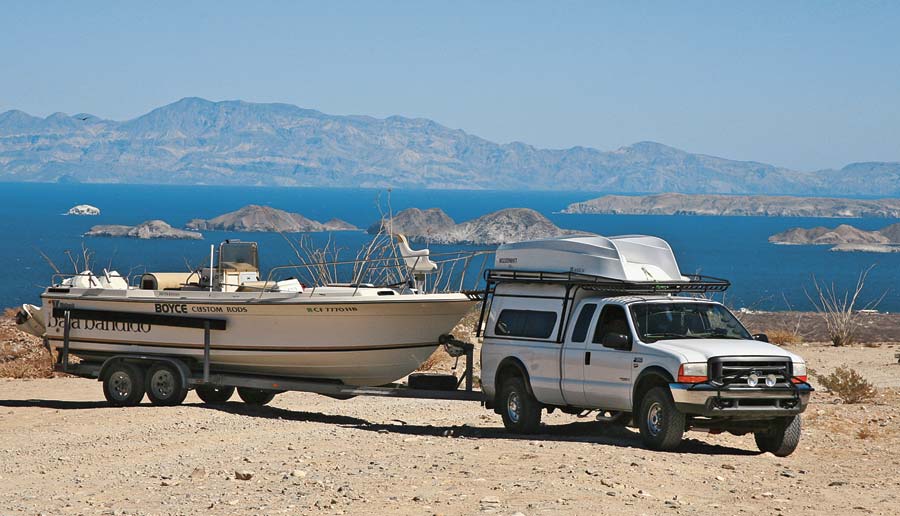
_Every angler who owns a trailerable boat dreams of taking it to fish-filled destinations. There’s freedom in having your rig and gear with you to muck about inshore or offshore.
Take your time and dabble, or spend all available moments devoted to a feverish mission. First sailfish or marlin? Take-home trout fillets? You control the timing and the pace.
Numerous North American ports hold excellent fishing opportunities, but some destinations stand out because they’re either heavily favored by adventure-seekers or they’re gems tucked in out-of-the-way places. Over the next seven pages, we’ll show you three. And check out our expert tips for safe trailering_ to any destination.
Road to Paradise
Mexico’s magnificent Sea of Cortez is well worth the tow
By Bill Boyce
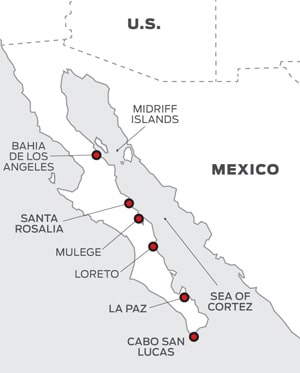
With news of drug cartels and bandits, the notion of towing your boat to Mexico might give you the jitters, regardless of how many fish await south of the border. Should it be considered? If your destination is the Sea of Cortez, the answer is yes.
Cradled between the Mexican mainland and the mountainous Baja California peninsula, the Sea of Cortez (aka Gulf of California) is a spectacle of natural beauty and awesome fishing for species such as dorado, striped marlin, roosterfish, sailfish, yellowfin tuna and more.
The most popular road to this angling paradise is Mexico Highway 1, Baja’s 1,060-mile main artery. It’s just two lanes with few shoulders or turnouts along most of its length, and it cuts through blistering deserts and tortuous inclines.
Still, Americans safely tow their boats every day to seaside towns such as Bahia de Los Angeles, Santa Rosalia, Mulege, Loreto, La Paz and Cabo San Lucas, as well as sleepy fishing villages in between. Here’s how they do it.
Truck/Trailer/Boat
With few road services, your towing rig needs to be in top shape. Pay special attention to tires (including the spare), brakes, belts and hoses, as well as filters, fluid levels, battery and alternator.
Most Baja trailer boaters use ¾-ton pickups with either gasoline or diesel engines. Quality fuel is readily available at Pemex stations along the highway, with relatively low prices thanks to Mexican government fuel subsidies.
If you plan to launch and retrieve your boat on unimproved ramps, four-wheel drive is a must.
There is a tendency to load extra gear in the boat for Baja, so make sure the trailer is not overloaded. A multi-axle trailer is more stable and, should you get a flat trailer tire, lets you limp to the nearest turnout (which could be miles away).
Have everything inspected, paying special attention to bearings and seals, the brake system, wheels and tires. When it comes to spare tires for trailers, there is a simple rule for Baja: You can’t have too many. Two spares is the minimum.
There is no ideal boat for fishing the Sea of Cortez, but most you see in Baja are between 20 and 26 feet in length. There seems to be an even split between outboard and sterndrive power.
No matter what size the boat, if it breaks in Baja, it is tough to find a mechanic or the parts to fix it, though your first priority might be finding a tow back to the ramp if you break down at sea. There are no commercial towing services in this part of the world.
Preventing a breakdown is the key, and this means meticulous boat maintenance and service ahead of time.
Baja can take a toll on equipment, particularly if you need to tow on an unpaved road for any distance. These dusty, washboardlike roads can rattle bolts loose and damage equipment. After a long tow, check out everything on the boat, as well as the trailer.
Safety in Numbers
To increase the safety factor, travel in a caravan with three or more other trailer boats. Nefarious types are less likely to target large groups. The U.S. club Vagabundos del Mar regularly organizes caravans of Baja-bound trailer boaters.
The other benefit of a caravan is that if you break down — on the road or on the water — others in the group are there to lend assistance and share spare parts.
Whether in a group or not, drive only in daylight hours, as animals such as cattle and burros tend to wander onto the roads at night.
Fishing Options
Dorado — April through November are the best months to find dorado (aka dolphin or mahimahi). They range from the tip of the Baja up to Bahia de Los Angeles. Feathers, small marlin lures and Rapalas work great. Cortez dorado find live baits such as Pacific mackerel irresistible. Look for dorado under any floating object such as driftwood or weed lines. The waters off Loreto are famous for dorado in late June and early July.
**
Striped marlin —** May through December are the best months for “stripers” near Baja’s tip, with June and July being peak months farther north in the Sea of Cortez. Abundance can vary from year to year, but these marlin — which average about 120 pounds — can be thick. Live Pacific mackerel cast to “tailing” fish is the most popular method. Trolled lures catch their share as well, but dropping back a live mackerel once a marlin appears behind the lures results in a higher hookup ratio.
Roosterfish — May through November are the best months in the lower Cortez to find roosterfish along the sandy beaches and inshore reefs. Live baits work best for the larger 40- to 60-pound fish. Small ladyfish work especially well for roosterfish.
Sailfish — June to October are excellent months to find Pacific sailfish as far up the Gulf as the Midriff Islands. Small marlin lures work great for these hungry billfish, and a live-bait offering is rarely ignored. Cortez sails are usually less than 100 pounds, but larger fish are sometimes caught.
Yellowfin tuna — From April on into November, throughout much of the lower Cortez you will find yellowfin tuna associated with porpoise schools. Trolling feathers and cedar plugs around the schools typically gets action if the tuna are hungry. Sizes range from “footballs” of less than 10 pounds to brutes in excess of 100 pounds.
California yellowtail — These upper Cortez favorites are found year-round, but they peak from May through November. Heavy metal jigs (worked yo-yo style near the bottom), trolled Rapalas and live Pacific mackerel all catch their share of these powerful jacks, which reach weights of 40 pounds or more.
With scores of other species — including several varieties of pargo (snappers), grouper, jacks and croaker — and breathtaking scenery, the Sea of Cortez is the ultimate trailer-boating getaway. Prepare your rig properly and drive carefully, and this angling paradise is yours to experience aboard your own boat.
Baja Resources
There are three great books on towing and fishing in the waters surrounding Baja California:
The Angler’s Guide to TrailerBoating in Baja
by Zack Thomas
www.bajatrailerboating.com
The Baja Catch
by Neil Kelly and Gene Kira
www.bajaquest.com
Sportfishing Atlas Baja California Edition
from Baja Directions
www.bajadirections.com
Required Papers
To legally enter, stay, drive, boat and fish in Mexico, you are required to have the documents below. So, make sure you bring the following:
- Passport
- Mexican Tourist Visa
- Vehicle, Trailer and Boat Registration
- Mexican Automobile Liability Insurance (minimum $25,000)
- Mexican Fishing License
To be on the safe side, you should also have Mexican boat insurance. Here two stateside resources to help you obtain the required Mexican documents, licenses and insurance:
Discover Baja
www.discoverbaja.com
Vagabundos del Mar
www.vagabundos.com
Time Travel
Trailer your boat to “Old Florida” for top inshore action
By Chris Woodward
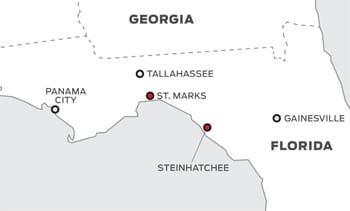
Florida — which means “flowery” in Spanish — could easily bear the name A Pescado: “fishy.” That certainly describes the entire coast of this sunny state, and it spells out the reason many anglers plan vacations to Florida’s various ports.
Anglers who trailer their own boats find welcoming locations throughout the state in virtually any season and for any species that swims in warm water. But few places carry quite as much Old Florida charm or deliver quite as much laid-back enjoyment as the state’s Big Bend region — where the Panhandle curves into the peninsula on the Gulf Coast.
Two towns in particular serve well as home bases for roaming this area: Steinhatchee and St. Marks. Both feature lush inshore estuaries, and boast excellent red drum and spotted seatrout fisheries. Steinhatchee also offers a robust grouper fishery offshore and ranks — with St. Marks — as a top destination for summer scallop harvesting.
Steinhatchee
Steinhatchee (pronounced STEEN-hatchee) lies just minutes upriver from the mouth of Deadman Bay and the Gulf of Mexico. With fewer than 2,000 residents, it could be described — most of the time — as a “sleepy fishing village.”
The town caters to anglers. It sports a new, three-lane boat ramp on the main drag, Highway 51. The facility offers on-site daily parking (no overnight trailer storage) and long lanes protected from wind and river current. Daily use fee is $5; it’s $20 for an annual permit. A second ramp on the south side of the Steinhatchee River in Dixie County, across from the Sea Hag Marina, features only one lane and limited roadside parking.
At River Haven Marina and Motel, located a short distance upriver from the new ramp, a 15-ton boat lift is available to launch and haul boats at a charge of $1 per foot for standard monohulls.
Most Steinhatchee anglers use bay boats or moderate-V vessels and focus on inshore fishing, since offshore action for amberjack, snapper and grouper generally begins about 20 miles out in 50-plus feet of water. Anglers may book offshore charters aboard properly equipped vessels through any of the local marinas.
Numerous captains also run inshore charters, which can be a great way to learn a new location. Just be sure to tell the captain your intentions.
As in many locations, fishing usually peaks at Steinhatchee in spring and fall. However, the region’s moderate climate permits nearly year-round fishing. Species include the prized trout and reds, plus mackerel, bluefish, cobia, jacks, flounder, snappers and grouper.
To target trout, most anglers head to the grass flats that fan out from the river mouth north and south. If the water’s clear, look for sand patches, and cast a jig and shrimp imitation — such as a 3-inch Gulp! bait — or a live shrimp under a popping cork. Light spinning or bait-casting tackle covers a broad range of opportunities and most nearshore species.
During the coldest times, trout move into deep holes upriver, where anglers troll plugs. In spring, cast topwater plugs toward potholes and along grass edges.
Redfish flock to marsh edges, oyster reefs and creek mouths most of the year. Use a live shrimp under a cork, spinnerbaits or gold spoons to create commotion.
During much of the summer — generally July 1 through Sept. 10 — angling opportunities mix with scallop season. Hordes of boaters descend, especially on weekends, to harvest the tasty bivalves, using snorkeling gear over shallow grass beds.
Steinhatchee accommodations vary from simple cottages to luxury condos; many offer on-site boat-trailer parking. Fuel is available at several local gas stations or at the marinas, which also offer bait, tackle, boat rental and repairs.
St. Marks
About 80 miles north of Steinhatchee, St. Marks lies upriver from Apalachee Bay in a historic area that hosts a national wildlife refuge amid acres of lush grass flats and creeks. “What the area lacks in offshore fishing, it makes up for with our great shallow-water opportunities,” says Capt. Dave Lear, a guide and freelance writer who has fished these waters for more than 25 years.
Lear targets the ubiquitous trout and redfish, but also finds Spanish mackerel, pompano and cobia in spring and fall, flounder most of the year, and tarpon averaging 90 pounds in summer.
St. Marks features two public ramps and a full-service marina — Shields Marina — with two deepwater ramps for boats to 36 feet. Shields charges $5 for ramp use and also sells nonethanol gas and diesel, live shrimp, frozen bait, marine supplies and tackle, and works on various engines and trailers.
The public ramp at San Marcos de Apalache Historic State Park can accommodate boats to the mid-30s. It’s located near the confluence of the St. Marks and Wakulla rivers just below town; the use fee is $5. The ramp at St. Marks National Wildlife Refuge lies just a quarter-mile from the bay, but it’s suitable only for skiffs, bay boats and small center-consoles, Lear says. The refuge charges a $5 entry fee; a $15 federal duck stamp serves as an annual pass.
Overnight trailer parking is generally available at area hotels; accommodations range from a quaint bed-and-breakfast to a rustic lodge or modern hotel. A few nearby gas stations sell standard fuel.
As in Steinhatchee, spring and fall are prime seasons for spawning trout and aggressive reds, Lear says. “With all the protected habitat in Apalachee Bay, it’s not unusual to catch trout pushing double digits. Reds range from teenagers to 30 inches on average.”
In winter, trout move into the rivers and reds begin tailing in larger schools, but both can be caught year-round. Lear uses light spin or bait-casting tackle with 10-pound braid or 8-weight outfits when fly-casting. For tarpon, he steps up to slightly heavier tackle.
From his 20-foot Bayshore flats skiff, Lear’s clients cast strictly lures and flies. His go-to trout lures include shrimp patterns, shad tails and jerk baits behind – or ¼-ounce jig heads. Best redfish lures include gold spoons in ¼- and ounce sizes. “I throw wooden topwater plugs for trout and reds too,” he says. “I like the buoyancy and action of wood over plastic.”
Live baiters generally use shrimp, pilchards and finger mullet under a cork. “It’s a common practice to float a live pinfish behind the boat while casting,” Lear says. “Shiner tails — a fresh pinfish with the head removed and then split down the middle — also account for lots of big trout and cobia.”
Before heading to any Florida destination, check trailering regulations and fishing laws at boatus.com/trailerclub/gulf_laws.asp and myfwc.com/fishing/saltwater/regulations. Saltwater-fishing licenses are required for residents and nonresidents.
Steinhatchee Resources
Taylor County Chamber of Commerce and Tourism Center
866-584-5366
www.taylorcountychamber.com
www.taylorflorida.com
Marinas (full service with lodging and guides)
River Haven Marina
352-498-0709
www.riverhavenmarinaandmotel.com
Sea Hag Marina
352-498-3008
www.seahag.com
Accommodations
Steinhatchee Landing Resort
800-584-1709
www.steinhatcheelanding.com
Steinhatchee River Inn
352-498-4049
www.steinhatcheeriverinn.net
Sunset Place Resort
(condos with dock)
352-498-0860
www.thesunsetplace.com
Charters
Pepperfish Key Charters
352-222-4085
352-498-9963
www.pepperfishkey.com
Something’s Fishy Charters
352-356-2554
www.somethingsfishycharters.com
Capt. Tommy Thompson
352-284-1763
www.flanaturecoast.com/capttommy
Plymouth Pilgrimage
Easy access, world-class variety awaits trailer-boating anglers_
By Tom Richardson_
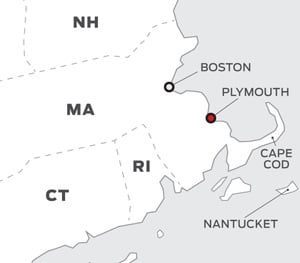
The hardest part of fishing out of Plymouth, Massachusetts, is deciding what species to target. While the abundance of game and food fish — namely striped bass, bluefish, cod, haddock, tuna and shark — no doubt pales in comparison with what the Pilgrims encountered here in 1620, the waters off Plymouth still offer great fishing for a variety of species.
You can be fly-casting for stripers on the flats, trolling the beachfronts for bluefish, deep-jigging the wrecks for groundfish and live-lining mackerel on Stellwagen Bank for giant bluefin tuna — all within an hour of the ramp.
I’ve made several tuna trips here, only to be waylaid by schools of surface-feeding blues and stripers in the main channel. In Plymouth, it pays to bring tackle appropriate to both inshore and offshore species — because you never know what you’ll encounter.
**
Access and Availability**
A 45-minute drive south of Boston, the Plymouth boat-launch facility is one of the most convenient in the state. It’s always open and features a two-lane concrete ramp, parking for more than 80 truck-and-trailer rigs, and a long courtesy floating dock that can handle several boats. The state manages the ramp, so anyone can launch and park for the $5 daily fee.
During the day, an attendant makes sure everything runs smoothly, a big plus on weekends when the ramp is a circus. While the lot often fills to capacity on weekends, I’ve never had a problem finding a spot early in the morning — or on weekdays. Plus, there’s a large turnover throughout the day.
The ramp can handle boats up to 35 feet and features a grade that allows access on most tides, no small consideration given the harbor’s average 10-foot tides. The only time anglers might have a problem is at dead-low tide, especially on moon tides, given the drop-off at the end of the ramp caused by people power-loading.
For service and fuel, two boatyards and several convenient gas stations can be found nearby. Dockside gas and diesel are available at Town Wharf Enterprises a few hundred feet from the ramp, and a Sea Tow franchise also covers these waters.
A great option, especially when vacationing with family or making an extended fishing trip, is to overnight on Cape Cod via anchor or by getting a mooring or slip, after launching in Plymouth. It’s about 20 to 26 nautical miles east of Plymouth Harbor, and you can leave your rig overnight at the ramp if you arrange it with the attendant and prepay for the second day.
A second option: Call Plymouth Boatyard to pick up your rig from the ramp and drop it off on your return, for a charge of $75. If you want, they will even inspect and service your trailer during your trip.
Several hotels and motels are located near the Plymouth ramp, and the Radisson and Governor Bradford hotels offer trailer parking facilities.
Seasons, Species and Tackle
The Plymouth ramp remains open year-round, although the state takes out the floating docks in winter. The docks return in April, around the start of spring cod season in Massachusetts Bay and on Stellwagen Bank. The cod, hake and haddock action has been relatively good in recent years, although you need to pick your days depending on weather.
Cod and other groundfish can still be taken later in the season, but you’ll have to make a longer run to the deepwater wrecks and rocky bottom east of Stellwagen to avoid the dogfish.
Fishing kicks into high gear starting in late May, when the first schools of striped bass arrive. The past two seasons have produced excellent fishing for stripers up to 40-plus inches inside the Plymouth-Kingston-Duxbury Bay complex. The light-tackle action can be world-class through June, with bass up to 30 pounds pushing bait onto the shallows of Duxbury and Kingston bays. Look for stripers feeding beneath flocks of gulls and terns.
If you’re new to this area, use caution: It’s easy to get lost while chasing fish in the maze of channels and flats. Make sure your paper and electronic charts are up to date, and pay close attention to the dropping tide. Follow the channel markers closely when making your way to and from the open water of Massachusetts Bay, or you could end up hard aground on infamous Browns Bank.
Of course, striper fishing is also terrific in the ocean waters outside the harbor. To the north, the rocks off Gurnet Light, High Pines Ledge and Howland Ledge are prime spots for casting plugs and jigs, trolling tube lures on wire line or live-lining mackerel. Trolling the 30-foot contour line south of the harbor — especially the rocky bottom off Manomet Point, Stellwagen Rock and Indian Hill — with tube-and-worm combos, large Hogies and big swimming plugs also accounts for big bass, as well as some monster bluefish.
The “backside” of Cape Cod, from Provincetown’s Race Point south along the beaches of the Outer Cape, has produced some of the best light-tackle striper fishing in recent years. Plenty of Plymouth-based anglers make the 20- to 25-mile run on calm days; it’s faster (and less stressful) than hauling a boat on and off congested Cape Cod during the summer.
You can also run “combo trips” targeting stripers and bluefin tuna, the latter available from mid-June through October. Plymouth affords good access to the bait-rich tuna grounds of Stellwagen Bank’s southern tip, just 18 miles northeast of the harbor entrance. If the action on the bank slows, it’s a short run southeast to other hot spots, like the Race, Peaked Hill Bar and the Golf Balls. Tuna can also be found inside the protective bowl of Cape Cod Bay.
While catching bluefins on flies and plugs or deep-jigging with spinning gear was possible four to five years ago, the majority of tuna in the past two years has been too large (100 to 300 pounds) to handle on anything less than 30-wide stand-up gear. Live-lining mackerel, menhaden and bluefish, trolling spreader bars and daisy chains, and chunking are standard methods these days.
No matter the species, Plymouth, Massachusetts, ranks as one of the country’s great venues for trailer-boating anglers. Just remember to bring a bunch of rods!
**
Plymouth Resources**
Destination Plymouth
800-872-1620
www.visit-plymouth.com
Plymouth Harbor Master
508-830-4182
www.plymouth-ma.gov
Bait and Tackle
Fisherman’s Outfitter
508-747-7440
www.fishermansoutfitter.com
Marinas and Boatyards
Plymouth Boatyard
508-746-0037
www.plymouthboatyard.com
Brewer Plymouth Marine
508-746-4500
www.byy.com
Accommodations
Best Western Plus Cold Spring
Plymouth, Massachusetts
800-678-8667
www.bestwestern.com
Radisson
Plymouth, Massachusetts
800-967-9033
www.radisson.com
Seabreeze Inn Bed and Breakfast
Plymouth, Massachusetts
866-746-0280
www.seabreezeinnbandb.com
The Governor Bradford on the Harbor
Plymouth, Massachusetts
800-332-1620
www.governorbradford.com
Cape Cod Slips/Moorings
Provincetown Harbor Marina
508-487-8899
www.marinaprovincetown.com
Wellfleet Town Marina
508-349-0320
www.wellfleetma.org
Fuel
On the road:
Route 44 Gas — On Route 44 a half-mile east of Route 3.
Cumberland Farms — On Route 44 just west of Route 3 overpass.
On the water:
Town Wharf Enterprises
508-747-6193

